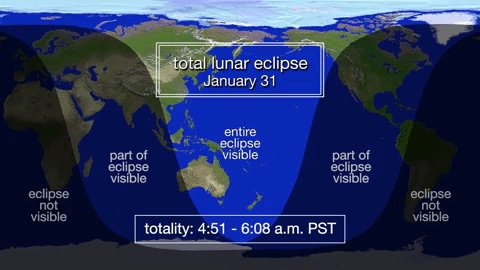"Super Blue Blood Moon"
NATURE & DISRUPT
AN INCREDIBLY CELESTIAL CONVERGENCE IN ONE NIGHT
Today, January 31 will play host to an incredibly rare celestial convergence , "Super Blue Blood Moon" a special total lunar eclipse with red moon no blue, as some imagine... 2018 surprises us with two supermoon on January and is the first time in 152 years, a supermoon, blue moon, and total lunar eclipse will coincide. The Jan. 31 full moon is special for three reasons: it’s the third in a series of “supermoons,” when the Moon is closer to Earth in its orbit -- known as perigee -- and about 14 percent brighter than usual. It’s also the second full moon of the month, commonly known as a “blue moon.” The super blue moon will pass through Earth’s shadow to give viewers in the right location a total lunar eclipse. While the Moon is in the Earth’s shadow it will take on a reddish tint, known as a “blood moon.” "Super Blue Blood Moon" It may sound like the apocalypse is nigh, so let's break it down by its three parts: "super," "blue" and "blood." A blue moon (a second full moon in a calendar month), a super moon (when the moon is unusually close to Earth, making it bigger and brighter) and a blood moon (a moment during an eclipse when the moon appears red) will all coincide for the first time since 1866. The eclipse begins at 5:51 AM ET, as the Moon is about to set in the western sky, and the sky is getting lighter in the east. NASA Television and the agency’s website will provide live coverage of the celestial spectacle beginning at 5:30 a.m. EST.

ART:"SUPER BLUE BLOOD MOON" by @msanhuezacelsi
www.msanhuezacelsi.portfoliobox.me
SUPERMOON, BLUE MOON, TOTAL LUNAR ECLIPSE & BLOOD MOON ALL IN ONE NIGHT
The supermoon is here! Be sure to bundle up then lead your “pack” outside to view the
The Jan. 31 full moon is special for three reasons: it’s the third in a series of “supermoons,” when the Moon is closer to Earth in its orbit -- known as perigee -- and about 14 percent brighter than usual. It’s also the second full moon of the month, commonly known as a “blue moon.” The super blue moon will pass through Earth’s shadow to give viewers in the right location a total lunar eclipse. While the Moon is in the Earth’s shadow it will take on a reddish tint, known as a “blood moon.”
What is the super blue blood moon? - video https://t.co/whhBpqZVn0— The Guardian (@guardian) 30 de enero de 2018
People from Moscow, via Sydney, to Washington DC will be given a rare celestial treat on Wednesday as three lunar phenomena coincide. Weather permitting, of course.
NASA Television and the agency’s website will provide live coverage of the celestial spectacle beginning at 5:30 a.m. EST.Beginning at 5:30 a.m. EST on Jan. 31, a live feed of the Moon will be offered on NASA TV and NASA.gov/live. You can also follow at @NASAMoon.
LIVE NOW: Watch views of the #SuperBlueBloodMoon from multiple telescopes. Take a look: https://t.co/a5ScGDXhQu— NASA (@NASA) 31 de enero de 2018
Wednesday, Jan. 31, 5:30 a.m.: Live stream of "super blue blood moon" and lunar eclipse, NASA TV. Weather permitting, the broadcast will feature views from the varying vantage points of telescopes at NASA’s Armstrong Flight Research Center in Edwards, California; Griffith Observatory in Los Angeles; and the University of Arizona’s Mt. Lemmon SkyCenter Observatory.
Watch the #SuperBlueBloodMoon live online! We'll have live streams from various telescopes starting at 5:30am ET. Set your alarms and tune in: https://t.co/Ah0LGiIadF pic.twitter.com/SzbMcPYCHt— NASA (@NASA) 31 de enero de 2018
Make sure you get outside to experience this lunar event for yourself! Weather permitting, the West Coast, Alaska and Hawaii will have a spectacular view of totality from start to finish (swipe to see the map). Unfortunately, eclipse viewing will be more challenging in the Eastern time zone. The eclipse begins at 5:51 AM ET, as the Moon is about to set in the western sky, and the sky is getting lighter in the east.
A blue moon (a second full moon in a calendar month), a super moon (when the moon is unusually close to Earth, making it bigger and brighter) and a blood moon (a moment during an eclipse when the moon appears red) will all coincide for the first time since 1866.
The opposite phenomenon, an apogee syzygy, has been called a micromoon, though this term is not as widespread as supermoon.
The two most recent supermoon occurrence was on December 3, 2017, and January 2, 2018. The one on November 14, 2016 was the closest supermoon since January 26, 1948, and will not be surpassed until November 25, 2034. The closest supermoon of the century will occur on December 6, 2052.
Occasionally, a supermoon coincides with a total lunar eclipse. The most recent occurrence of this was in September 2015, while the next one will be in January 2018.
SUPERMOON
The name supermoon was coined by astrologer Richard Nolle in 1979, arbitrarily defined as:
... a new or full moon which occurs with the Moon at or near (within 90% of) its closest approach to Earth in a given orbit (perigee). In short, Earth, Moon and Sun are all in a line, with Moon in its nearest approach to Earth.
Nolle also claimed that the moon causes "geophysical stress" during the time of a supermoon. Nolle never outlined why he chose 90%.
The term perigee-syzygy or perigee full/new moon is preferred in the scientific community. Perigee is the point at which the Moon is closest in its orbit to the Earth, and syzygy is when the Earth, the Moon and the Sun are aligned, which happens at every full or new moon. Hence, a supermoon can be regarded as a combination of the two, although they do not perfectly coincide each time.
Global map showing areas of the world that will experience (weather permitting) the Jan. 31, 2018 “super blue blood moon.
Credits: NASA
If you live in North America, Alaska, or Hawaii, the eclipse will be visible before sunrise on Jan. 31. For those in the Middle East, Asia, eastern Russia, Australia and New Zealand, the “super blue blood moon” can be seen during moonrise in the evening of the 31st.
Stages of the Jan. 31, 2018 “super blue blood moon” (weather permitting) are depicted in Pacific Time with “moonset” times for major cities across the U.S., which affect how much of the event viewers will see. While viewers along the East Coast will see only the initial stages of the eclipse before moonset, those in the West and Hawaii will see most or all of the lunar eclipse phases before dawn.
Credits: NASA
Johnston has been following and writing about the Moon since 2004, when he and about 20 colleagues at NASA Headquarters would get together after work during the full moon in “celebratory attire”—which for Johnston meant his signature bow tie. Long after the socializing fell by the wayside, Johnston’s monthly blog lives on, with a dedicated following on NASA’s lunar website, moon.nasa.gov.
Said Johnston, “I have always been fascinated by the night sky. Most of what we can see without a telescope are points of light, but the Moon is close enough that we can see it and the features on it, and notice what changes and what stays the same each night.”
To watch a NASA ScienceCast video, A Supermoon Trilogy about the Dec. 3, 2017, Jan. 1, 2018, and Jan. 31, 2018 supermoons, click here.
Love to observe the Moon? It’s easy to make a Moon Phases Calendar and Calculator that will keep all of the dates and times for the year’s phases of the Moon at your fingertips.
Take notes and record your own illustrations of the Moon with a Moon observation journal, ready to download and print at moon.nasa.gov.
Natural disasters
There is no correlation between supermoons and major earthquakes. Regardless of the evidence, there has been media speculation that natural disasters, such as the 2011 Tōhoku earthquake and tsunami and the 2004 Indian Ocean earthquake and tsunami, are causally linked with the 1–2 week period surrounding a supermoon. A large, 7.5 magnitude earthquake centred 15 km north-east of Culverden, New Zealand at 00:03 NZDT on November 14, 2016, also coincided with a supermoon.
Supermoon 2018: When and How to See January's Two Full Moons
BY JESSE EMSPAK AND TARIQ MALIK VIA SPACE.COM
When the "Super Blue Blood Moon" rises on Wednesday, Jan. 31, it will also be the last of two "supermoons" in 2018, both of them in January, the first was "Full Wolf Moon" on Monday, Jan. 1.
This January's supermoon is actually the 3° of three back-to-back supermoon full moons to come in the next two months. The full moon also occurred near perigee on Dec. 3 and will again on Jan. 31, according to NASA, which billed the line up as a supermoon trilogy. The Jan. 31 supermoon is also the second full moon of January, making it a blue moon, and also occurs during a total lunar eclipse.
SOURCE: SUPERMOON by WIKIPEDIA (CC BY SA)
ART:"SUPER BLUE BLOOD MOON" by @msanhuezacelsi
www.msanhuezacelsi.portfoliobox.me
‘Super Blue Blood Moon’ Coming Jan. 31 by NASA
https://www.nasa.gov/feature/super-blue-blood-moon-coming-jan-31
Last Updated: Jan. 30, 2018
Editor: Tricia Talbert
INFOGRAPHIC:
Supermoon 2018: When and How to See January's Two Full Moons
BY JESSE EMSPAK AND TARIQ MALIK VIA SPACE.COM"No Copyright Infringement Intended, Strictly For Promotional Purposes Only! All Rights Reserved To Their Respective Owners."
"Copyright Disclaimer Under Section 107 of the Copyright Act 1976, allowance is made for "fair use" for purposes such as criticism, comment, news reporting, teaching, scholarship, and research. Fair use is a use permitted by copyright statute that might otherwise be infringing. Non-profit, educational or personal use tips the balance in favor of fair use."














































0 comentarios :